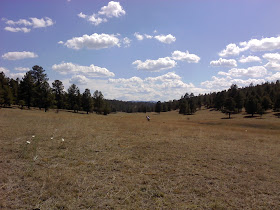Becoming a Firefighter
Hello anyone out there who still reads this. It's been a while. February was a ridiculously busy month. I didn't have one weekend off. The first two weekends, I had to drive to Silver City. Yes, I had to drive there and come back... twice. But I didn't mind, because I was doing something I really wanted to do, which was... firefighter training!
Last summer, while I was off breaking the truck, the rest of my crew was in Arizona doing remediation work on the Wallow Fire. I was the only one out of my entire staff (including the students) without fire training and therefore couldn't go along. Needless to say, I felt left out. At the end of the fiscal year, our travel budget was cut (again) and I thought there wouldn't be any extra money for trainings, so I tried not to be too disappointed about another summer of working alone while everyone else went off without me again.
But when I got back from the holiday break, something incredible happened. My boss came by and said, "We have some extra travel money, and W [his boss] wants you take fire training this year, so... find a class." YAY!
It was actually really hard to find a class. I kept getting different information and getting referred to different people. But I finally found one. In Silver City. Over two weekends. Silver City is about 4 and 1/2 hours away, if you take the shortcut. More if you try to go through Hatch and Deming. And even longer if you have to do what I did last year, and go all the way down to Las Cruces. Blah. So it was a long drive and totally killed my weekends but, like I said, I really wanted to do it, so I sucked it up and went.
The weekend of Feb 4 and 5 was the first weekend of the training, and I learned A LOT. There is so much information. We learned all about wildland fire behavior in one day. And then took a test. So in one day, I had already completed 1/4 of the 4-part course. The class was actually pretty big, with about 30-32 people, most of them volunteer firefighters from different departments around Southwest New Mexico. It's weird to see all these middle aged and older people who want to fight fires for no money, when all I really want to do is go around and look at stuff that's already been burned (because I'm a wussie) and get paid for it.
 |
| Required reading for firefighters. |
Wildland fire behavior reminded me a lot of physical geography, because it deals with how weather affects fire. Wind, thunderstorms, relative humidity, air temperature, etc. I also learned a lot about how the actual fire behaves. It's pretty cool, actually.
And now, because my geology professor once said that drawing pictures helps you learn and remember things, I give you the parts of a fire:
 |
| In case you cannot tell from my amazing drawing skills, this is a fire in aerial view |
Origin - Every fire has an origin, but it's not always at the lowest point on the fire like I've drawn. There can be other factors, like the tree that initially ignited could have fallen and rolled down the hill, thus bringing the fire down with it.
Head - this is the biggest, scariest part of the fire. It's the place where the fire is spreading the fastest.
Flank - These are basically the sides of the fire that aren't the head. They are the coolest part of the fire (temp-wise), so that's where the firefighters are usually sent first to start containing or controlling the fire. They say go up the right or left flank instead of using directions like North, South, East and West, because it's too hard to tell that kind of thing when there's a fire burning all around you.
Heel - This is the "bottom" of the fire. It has the slowest rate of spread and is opposite the head.
Finger - Extension that is still connected to the main fire
Pocket - Unburned portion between the finger and the main fire. You DON'T want to be there. If the fire jumps across and closes the pocket, you are screwed.
Island - A part inside the fire that isn't burning. It may be a rock outcrop or a lake or a change in fuel type. Just something different that decided not to burn for some reason.
Spot Fire - These happen when a piece of fire (yes I said piece, whatever) is lofted out into the atmosphere and lands on a fuel bed. It's not connected to the main fire.
The entire outer boundary of the fire is called the perimeter and the already burnt middle part is called the black, so I made it black in the picture. Doesn't it totally look like a burnt forest? Yeah, I thought so.



I'm still reading, I have just had a busy few weeks as the summer wanes....Fire training sounds like cool thing to know but perhaps not something you want to have to use. Better to have it and not need it though rather than the other way around though :)
My father was a firefighter, though more of the burning aircraft kind than the burning forest kind. I'll ask him if ever did any training like this next time I see him.
That sounds like a busy and intense 4 days of training.
I'm glad you won't be stuck working by yourself again. It gets so lonely - I understand